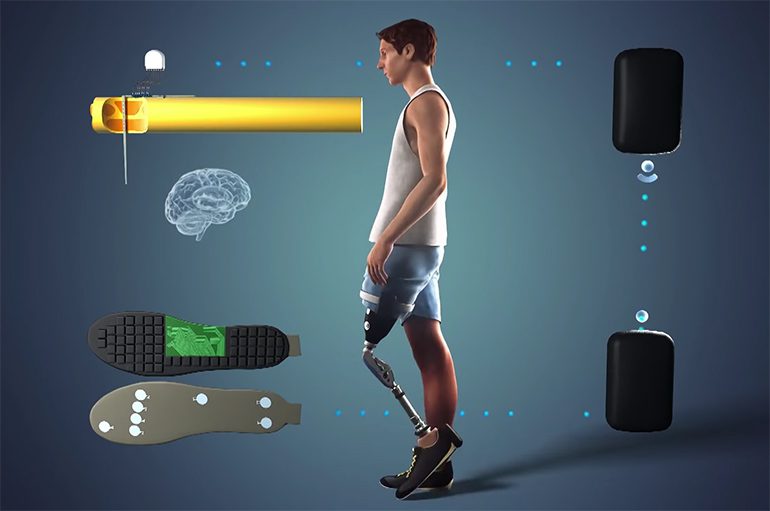
Neurotechnical advancements bring promise to amputees. Professor Stanisa Raspopovic and his research team have made a breakthrough in below-knee prostheses. Imagine having a lower leg prosthesis that is so sensitive that when it is resting on a wall, you feel the pressure of the wall on your stump!
Neurotechnical research is the integration of your existing neural system with your prostheses. Dr. Raspopovic was awarded the 2021 Science & PINS Prize for Neuromodulation for these innovations in neurotechnology. His ability to create prostheses that have a neurological component that brings sensation back after an amputation. His team created a new class of artificial legs that led to an improved quality of life for amputees. Neurotechnical advancements bring promise to amputees.
Lower Limbs Left Behind
New neurotechnical advancements bring promise to amputees. Almost all prosthesis research money is going to the development of fingers and hands. There is a higher priority in providing the use of a hand than in restoring the ability to walk. Prosthetic leg replacement has had no significant improvements since 1990. The technology is very available. “I believe that the focus on upper limb amputation was because of the human fascination with the hand,” says Raspopovic. The rise of peripheral arterial disease, such as diabetes, has seen the number of lower limb amputations far outstrip upper limbs. There are five hundred foot amputations every day in the United States alone. Yet the restoration of hands and fingers has a higher priority.
Intuitive Contact Brain to Prosthesis
There are more clinical options available for upper limb amputees. “You can do well with a static solution or with the complex use of the residual arm,” says Raspopovic,” individuals who have lost a leg need a mobile prosthesis to restore function.” Raspopovic is not impressed by the advances in robotics and mechanical design. Instead, he wants to improve the brain prostheses connection so that you feel connected to the ground. “We tried to design a device that would enable intuitive contact with the residual nervous system,” he says. “This is what patients want. They don’t want a device that they have to struggle with. They want to use it intuitively.” Raspopovic wants the prosthesis and the amputee to bond.
Neurotechnical advancements bring promise to amputees. The team first looks at intact limbs. They carefully study the connections between the amputee’s brain and their peripheral nerves. The goal is to be able to map out exactly which nerves contributed to normal gait and movement. They then can develop an exact design with implanted electrodes to stimulate targeted areas of the nervous system. They created a sensory experience for prosthesis users that naturally mimics the feeling of an intact leg, making it a seamless generic fit and nerve connection.” We managed to create a language of stimulation that is appropriate to speak to the nervous system about the prosthesis. But, this research took a decade to become a reality,” Raspopovic explains.
Raspopovic’s leg recreates natural feelings of touch and pressure for the user. In addition, they created a connection so reliable that even when the amputee removed the prosthesis, they could tell if it was moved or falling over. The sensors will connect with the stump even when taken off. This creates a bond between the amputee and the prosthesis that is almost organic. Many patients express it as if they have grown another leg. Users’ ability to navigate rugged terrain is also substantially improved. Significant improvements in gait and stability have been reported. Fears of falling are significantly reduced as they can feel where they are stepping. They can feel movement in the ankle and shin as the ground becomes more uneven.
Reducing the risk of heart attack
The system had benefits beyond restoring movement. It reduces heart attack risk. Amputees using traditional prostheses suffer from an increased risk of heart disease brought on by a larger metabolic load when walking. “They suffer because their biomechanics are irregular,” says Raspopovic. “You can see even when they are just climbing a staircase; they will be significantly more fatigued when compared to a non-amputee.” Psychological and cardiovascular stress is prevalent in lower limb amputees. Each of these factors may have systemic consequences on the arterial system and may contribute to the increased cardiovascular morbidity in traumatic amputees. By restoring the sensation of normal gait, users of Raspopovic’s device were able to command more efficient movements and reduce their metabolic effort.
New Treatment for Phantom Pain
Amputees regularly suffer the intractable burden of phantom limb pain (PLP), where intense, uncontrollable pain emanates from the limb that is no longer there. Raspopovic’s implanted electrode system could be set to a “neuro-pacemaker modality,” where it releases signals to the residual nerve that reduce the surge of phantom limb pain. By focusing on stimulation that more naturally mimicked movements produced from an intact limb, Raspopovic’s essay suggests that the system can remodel the peripheral and central nervous system to bring about a curative, rather than just painkilling effect on phantom limb pain. Many amputees who can’t sleep because of phantom limb pain know what this research is saying and its consistency in other neurological treatments for intractable phantom pain.
Artificial Limbs As Part of Their Bodies
The most significant benefit of Raspovic’s artificial limb is not measured in a reduction on a pain scale or in the number of steps walked without a fear of falling. Instead, the improvement in how the amputee feels that his prosthesis has become a part of their body made the most significant difference. Despite typically being less than half the weight of a flesh and bone leg, traditional prostheses are often described as being uncomfortably heavy by users. In addition, increased cognitive load when using these older prostheses shows that the nervous system struggles to incorporate its new biomechanical component. In contrast, users reported improvements both in the “weight” of Raspopovic’s limb and showed reduced cognitive load when using it.
Patient Benefits
Neurotechnical advancements bring promise to amputees. The distinguished 2021 Science & PINS Prize for Neuromodulation was given to Raspopovic because his invention was so remarkable. It gave the amputee’s the feeling that their foot was still there. Raspopovic’s essay discusses the societal benefits of a prosthetic system that could restore natural movement while reducing pain and cardiovascular burden. His greatest motivation is his designs’ benefits to individual patients. A survey distributed to patients who had used his system showed fantastic satisfaction. Once the amputees felt bonded to their prosthesis they write that it was like they grew a new leg. In response to one question, “What would provide the biggest benefit?” one user said, “This prosthesis makes a world of difference.”
Neurotechnical advancements bring promise to amputees. The system combines three functions—intuitive motor control, touch, and sensation. “We modified a prosthetic leg with this complex bionic system which enables wearers to move their prosthetic more intuitively,” said lead investigator Paul Marasco. By providing more realistic physical feedback and helping to alleviate phantom limb pain, Raspopovic’s system led amputees to report a sense of “embodiment,” or the feeling that a prosthetic is an extension of the wearer’s body. Raspopovic wants to make the prostheses available to all who could benefit from it. “I like the part of the job where we are helping somebody. It’s what is pushing us forward. I wouldn’t do anything in life rather than this work,” he concludes.





